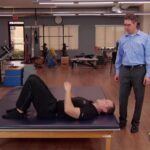Dead Bug Exercise | Early Intervention Ergonomics
What is the Dead Bug Exercise?
The Dead Bug Exercise is a popular core exercise that targets the muscles of the abdominal area and lower back. Furthermore, it is commonly used in fitness training, physical therapy, and rehabilitation programs. Interestingly, the exercise gets its name from the way it resembles a dead bug lying on its back with its legs and arms in the air.
Here’s how to perform the Dead Bug Exercise:
- Start by lying flat on your back on a mat or the floor. Bend your knees and lift your legs so that your thighs are perpendicular to the floor. Your lower legs should be parallel to the floor, creating a 90-degree angle at the knees.
- Raise your arms straight up toward the ceiling, extending them directly above your shoulders. Additionally, ensure that your palms are facing each other.
- Brace your core muscles by drawing your belly button in toward your spine. This will help stabilize your spine throughout the exercise.
- Begin the movement by simultaneously extending your right leg forward and lowering your left arm overhead until they are a few inches above the floor. Keep your lower back pressed into the floor throughout the movement to maintain stability.
- Return your leg and arm back to the starting position and repeat the movement on the opposite side, extending your left leg and lowering your right arm.
- Continue alternating sides in a controlled manner, maintaining proper form and alignment. Exhale as you extend your leg and arm, and inhale as you return to the starting position.
This exercise helps to strengthen the deep core muscles, improve stability, and promote better posture. It can be modified to suit different fitness levels by adjusting the range of motion or adding resistance, such as holding a stability ball or using resistance bands.
Early Intervention Benefits
The Dead Bug Exercise offers several early intervention benefits. Here are some of them:
- Core Strengthening: The Dead Bug Exercise primarily targets the muscles of the core, including the rectus abdominis, transverse abdominis, and obliques. By engaging these muscles, it helps improve core strength and stability. A strong core is essential for maintaining proper posture, supporting the spine, and enhancing overall functional movement.
- Spinal Stability: The exercise promotes spinal stability by challenging the muscles that surround and support the spine. It helps develop a strong and stable core, which can reduce the risk of back pain and injuries. By improving spinal stability, this exercise can also contribute to better posture and alignment.
- Balance and Coordination: The alternating leg and arm movements in the Dead Bug Exercise require coordination and balance. Moreover, regularly practicing this exercise can enhance neuromuscular coordination, thereby helping you improve your balance and body control not only in the workplace but also in various other activities.
- Injury Prevention: The Dead Bug Exercise can help prevent injuries by strengthening the core and improving stability. Moreover, a strong core provides a solid foundation for movements, thereby reducing the risk of excessive strain on the lower back. Additionally, it can help improve body mechanics and decrease the likelihood of overcompensation by other muscles, ultimately minimizing imbalances and potential injuries.
- Rehabilitation and Posture Correction: The Dead Bug Exercise is commonly used in physical therapy and rehabilitation programs. It can be effective in rehabilitating and strengthening the core muscles after certain injuries or surgeries. Additionally, by targeting the muscles responsible for maintaining good posture, the exercise can assist in correcting postural imbalances and promoting a more aligned and stable body position.
Things to Remember
It’s important to perform the Dead Bug Exercise with control and avoid arching your back or allowing your lower back to lift off the floor. As always, consult with a qualified fitness professional or healthcare provider before starting any new exercise program.
Remember, while the Dead Bug Exercise offers numerous benefits, it’s important to perform it with proper form and technique to maximize its effectiveness and minimize the risk of injury. If you have any specific concerns or pre-existing conditions, consult with a qualified fitness professional or healthcare provider to ensure it’s suitable for you.
These early intervention exercises are to improve overall health & fitness as well as help reduce work-related injuries.
If you have an injury or illness, consult with a health care professional before attempting.
Contact us for more information on how we can help your employees stay safe.
Resources
More Tools & Resources from Peak Ergonomics
Contact Us About Reducing Workplace Injuries
Healthy Employees are the Bottom Line! – Learn More!

